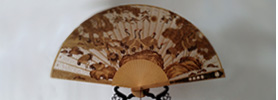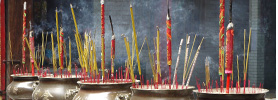|
Properties and uses of Sandalwood is commercially
known as Sandalwood Oil. The heartwood that constitutes
the central part of the tree is valued for its
fragrance. Sandalwood Oil is used in perfumes,
cosmetics, aromatherapy and pharmaceuticals. Extensive
research has shown that sandalwood exhibits considerable
genetic diversity for different traits. Sandalwood Oil
recognized as a medicinal treatment in
pharmacopoeias from a variety of countries, including
Britain, France, Japan and Belgium.
To produce commercially valuable sandalwood with high
levels of fragrance oils, the harvested “WILD” trees
have to be at least 60 years of age.
Unlike most trees, sandalwood is harvested by
toppling the entire Santalum tree instead of sawing them
down at the trunk. This way, valuable wood from the
stump and root can also be sold or processed for oil.
Sandalwood Oil is a pale yellow to yellow viscous
liquid, with a sweet, fragrant, persistent, spicy, warm,
woody, milky and nutty notes.
 
Medicinal
Traditionally, the fragrant heartwood of sandalwood
trees was used in medicines. The Sandalwood Oil is
approved for use by the US Food and Drug Administration,
Flavour and Extract Manufacturers Association, Council
of Europe and Joint FAO/WHO Expert Committee on Food
Additives.
On account of acute scarcity of Sandalwood Oil,
search for novel synthetic raw materials imitating the
characteristic odour profile of Sandalwood Oil has
become a challenging task. Extensive studies are being
carried out to investigate the structure–odour
relationship.
The oil is used for its therapeutic effects in
Ayurveda, Chinese and Tibetan medicinal systems. It is
used in the treatment of common colds, bronchitis,
fever, dysentery, piles, scabies and infection of the
urinary tract, inflammation of the mouth and pharynx,
liver and gall-bladder complaints and as an expectorant,
stimulant, digestive and as a muscle relaxant.
A recently conducted in vitro study has shown that
Sandalwood Oil is effective on methicillin resistant
Staphylococcus aureus (MRSA) and antimycotic-resistant
Candida species. In another study, a crude extract as
well as isolated compounds of Sandalwood Oil (primarily
α- and β-santalol) showed antibacterial activity against
Helicobacter pylori, a Gram-negative bacterium which is
strongly linked to the development of duodenal, gastric
and stomach ulcers.
Sandalwood Oil exhibited virulence against isolates
of drug-resistant herpes simplex virus type I. The oil
also showed anti-carcinogenic activity. A recent study
reports that β-santalol exhibited anti-influenza A/HK
(H3N2) virus activity of 86% with no cytotoxicity at the
concentration of 100 μg/ml. Sandalwood Oil elevates
pulse rate, skin conductance level and systolic blood
pressure and brings about higher ratings of
attentiveness and mood in humans.
 
Cosmetic / Perfume
The oil from the heartwood, extracted by steam
distillation or by solvent, is used for cosmetics,
perfumery, aromatherapy and medicinal purposes.
It is extensively used in perfumery, cosmetics,
aromatherapy and pharmaceutical industry. The attributes
are due to two forms of a sesquiterpene alcohol –
α-santalol (7– 60%) and β-santalol (7–33%). Being good
fixatives these are highly valued in perfumery and
toiletry industry, especially for certain delicate
scents that are extremely rare and fragile. No
composition of the heavy or oriental type of perfume is
complete without an ample dose of Sandalwood Oil.
Most perfumery and toiletry industry use Sandalwood
Oil as the base because of its inherent capacity to
absorb most of the ethereal notes of other whole herbs
or flowers, as it can enhance their perfumery status and
stability. Perhaps one of the most precious perfumery
materials from antiquity down to modern times, the
popularity of Sandalwood Oil has shown no signs of
waning.
 
Carving / Art
The heartwood is described as astringent, bitter,
moderately hard, heavy, durable, yellow or brown in
appearance, with an oily texture and is an exquisite
material for carving intricate designs.
The carved images of gods and mythological figures have
a high demand in the market. It is no wonder that
Sandalwood is the most expensive wood in the world. A
wide variety of articles such as boxes, cabinet panels,
jewel cases, combs, picture frames, hand fans, pen
holders, card cases, letter openers and bookmarks are
made from Sandalwood.
 
Ceremonial / Religious
Importance
A mixture of heartwood and sapwood is powdered and
made into incense or joss-sticks which are used in
eastern religious ceremonies. Sandalwood is sacred and
is used in religious ceremonies and is an important
ingredient in ‘homa’ (havana), a Sanskrit word which
refers to any ritual in which making offerings into a
consecrated fire is the primary action. Among the
Buddhists, Sandalwood is burnt during prayers and
meditation.
Sawdust, wood shavings from carving, or wood residue
after oil distillation may be used. The sapwood is white
or yellow and not scented, and is used in preparing
turnery item and agarbattis.
The aromatic of the sandalwood lower trunks and root
stock of native Santalum species were harvested in great
quantity and shipped to China, where they were used to
make incense, fine furniture, and other desirable
products.
 
|